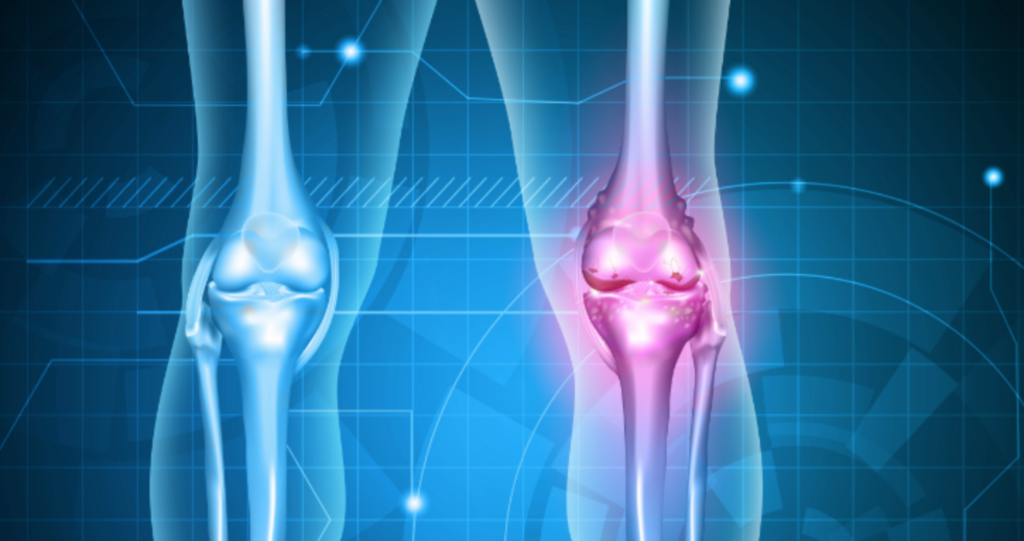
Glucosamine is a compound derived from amino acids that plays an important role in preserving joint health. Glucosamine seems to be able to help reduce the inflammation and pain associated with arthritis in your joints, possibly by helping to rebuild damaged cartilage and slow the progressive loss of joint space that occurs in the disease.
Many people find that glucosamine is helpful for other kinds of joint pain as well, but the primary focus of current research is on treating pain related to osteoarthritis, the progressive degeneration of the cushioning capabilities of the cartilage in your joints.
Need a glucosamine supplement to relieve your joint pain? Don’t worry, our research team has you covered.
Here are the best glucosamine supplements available right now.
1. Kirkland Signature Glucosamine With MSM
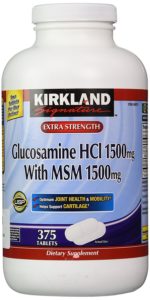
Click here for the lowest price on Amazon
Kirkland Signature is known for providing simple and efficient supplements that address your basic needs. This one is no exception.
The dosage of glucosamine in each tablet is solid, at 750 mg, and it has MSM, another popular joint supplement included in equal proportions.
The capsules are held together with perhaps more binders and fillers than the most stringent of purists might like, but this supplement is still a winner.
2. Schiff Glucosamine

Click here for the lowest price on Amazon
Schiff’s glucosamine formulation delivers 1000 mg of glucosamine hydrochloride per tablet, along with 1.6 mg of hyaluronic acid, which is thought to assist with the cartilage regeneration properties of glucosamine.
The high dose is great, but purists won’t like the additives, emulsifiers, and coloring agents included in the capsule.
3. Vimerson Health Glucosamine Chondroitin Turmeric & MSM
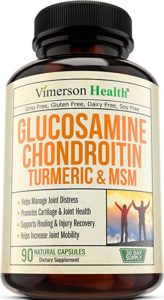
Click here for the lowest price on Amazon
This multi-ingredient joint supplement from Vimerson is popular because it delivers a balance of various ingredients that are thought to help with joint pain.
However, one downside of this diversity of ingredients is that the ability to deliver a high dosage of the main ingredient (glucosamine) is limited. Each tablet contains only 500 mg of glucosamine, so you’ll have to take multiple tablets to get enough to make a big difference in joint function.
4. Made in Utah Glucosamine Chondroitin Turmeric MSM

Click here for the lowest price on Amazon
Made in Utah caters to people expecting a slightly higher quality of supplement with this joint support product.
It’s got a solid 500 mg of glucosamine per tablet, along with chondroitin, turmeric, and MSM (as the name suggests) plus a few less common extras. Boswellia extract, quercetin, and methionine are all thrown into the mix to increase the anti-inflammatory and pain relieving power of the supplement.
5. Zenwise Advanced Strength Joint Support

Click here for the lowest price on Amazon
Zenwise makes a joint supplement that is among the best when it comes to all-around joint regeneration.
If it’s glucosamine specifically that you are looking for, it’s more middle of the road with 500 mg of that supplement per tablet.
In addition to the other typical joint supplement ingredients (MSM, chondroitin, hyaluronic acid) you’ll also find the herbal extracts boswellia and curcumin, which are thought to have anti-inflammatory properties.
6. Nutriflair Premium Glucosamine Chondroitin Turmeric MSM
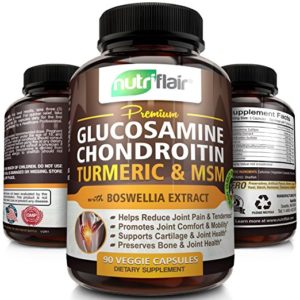
Click here for the lowest price on Amazon
As another multi-ingredient supplement focused on joint health, Nutriflair’s take on glucosamine is pretty good, with 500 mg of glucosamine per tablet, as well as the namesake extras and quercetin and methionine for good measure.
The lack of extra filler compound is appealing to people who want to keep the additives in their supplement to a minimum.
7. NOW Glucosamine
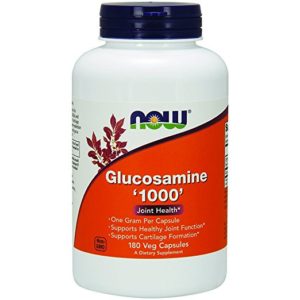
Click here for the lowest price on Amazon
NOW Glucosamine delivers the “big three” you’ll see in most joint supplements: glucosamine, chondroitin, and MSM. The doses are respectable, but not great.
The good news is that there aren’t any extraneous ingredients, binders, or coloring agents, which will make this supplement appeal to people who appreciate minimalist supplement design.
8. Doctor’s Best Glucosamine Chondroitin MSM

Click here for the lowest price on Amazon
Doctor’s Best makes a glucosamine supplement that tries to do too much at once. The presence of all of these different joint regulating supplements leaves little room for a proper dosage for each.
One serving does deliver 1500 mg of glucosamine, but you need to take four whole tablets to get that dosage. It’s an alright supplement if you are okay going through bottles pretty rapidly, but if your main focus is just glucosamine, you’ve got better options.
9. Vitabreeze Glucosamine Chondroitin MSM & Turmeric
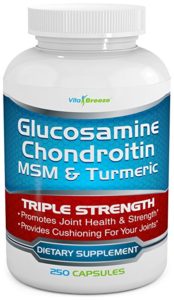
Click here for the lowest price on Amazon
While it’s incredibly popular, Vitabreeze’s take on the multi-ingredient joint support supplement will fall short for people looking for something that provides a large dose of glucosamine.
With under 400 mg of glucosamine per tablet, all the extras like MSM and chondroitin take up too much tablet space to allow a large dosage.
As with other low dose supplements, you can get around this by just taking more, but it does mean you’ll go through bottles a lot faster.
10. BlueBonnet Glucosamine Chondroitin Plus MSM

Click here for the lowest price on Amazon
BlueBonnet is a company that has a stellar reputation for high quality and high purity supplements.
While the company is very clear about where the ingredients are sourced from, the actual glucosamine content per tablet is quite low, making it hard to recommend for anyone looking for a high dose of glucosamine.
Glucosamine benefits and side effects
Glucosamine is a chemical combination of an amino acid and a sugar–essentially a complex carbohydrate–that reduces joint pain.
In many cases, joint pain is the result of irritation, inflammation, or degeneration of the cartilage surface inside your joints. Glucosamine appears to help fight this by encouraging your cartilage to absorb more water, keeping the cartilage hydrated.
It may also help increase the synthesis of cartilage tissue. People have found glucosamine helpful in reducing joint pain (especially joint pain caused by arthritis) for a long time, but recently there has been more scientific evidence demonstrating the benefits of glucosamine.
Benefits
Initial evidence from smaller scientific experiments on the utility of glucosamine at treating joint pain stretches back to the early 1980s.
One of the original studies, published in 1981 in the medical journal Pharmatherapeutica, tested the effects of a 400 mg glucosamine supplement over the course of a few weeks in a group of 30 people with arthritis (1).
The results were promising: the patients who received the glucosamine supplement recorded significant improvements in their pain levels.
Later research used larger groups of patients to test whether glucosamine could actually help treat or even prevent osteoarthritis.
A 2001 study published in the prestigious journal The Lancet followed a group of 212 subjects with early-stage knee osteoarthritis (2).
Half the subjects were given a 1500 mg glucosamine sulfate supplement, while the other half were given a placebo and acted as a control group. All of the subjects were followed for three years, and the degree to which their osteoarthritis progressed was evaluated by x-rays.
At the study’s conclusion, the authors found that the group given the glucosamine supplement had no joint space narrowing, while there was a statistically significant decrease in joint space in the control group.
This indicated that the glucosamine was effective at slowing (or perhaps even stopping) the progression of osteoarthritis in the knee.
The actual mechanism of action of glucosamine appears to be related to its ability to encourage cartilage to maintain its health, either through increasing its water retention or actually synthesizing new cartilage tissue.
A study published in 1998 by a team of scientists in Italy exposed human cartilage tissue from the head of the femur to a solution of glucosamine sulfate (3).
They found that the glucosamine increased the synthesis of a type of protein called proteoglycan, which make up a significant amount of the mass in cartilage.
The increase in production of this protein lasted for approximately 12 days following exposure to glucosamine. This provides a plausible mechanism for how glucosamine might reduce the loss of joint space, slowing the progression of osteoarthritis.
While decreasing the destruction of the joint space that happens in osteoarthritis is important, reducing pain levels is the ultimate goal, so researchers turned their attention to larger trials that actually evaluated patient outcomes. In this case, the connection between glucosamine and positive outcomes is less clear.
A paper published in the Annals of Rheumatic Diseases conducted a large, placebo-controlled trial of over 600 subjects that compared glucosamine to a placebo in patients with osteoarthritis over the course of two years (4).
The study found similar results to the previous work on joint space narrowing: the glucosamine slowed the rate at which the joint space narrows in people with osteoarthritis.
However, it failed to find a statistically significant difference in pain outcomes: the people who got the placebo reported the same amount of pain improvement as the people who took the glucosamine supplement.
Not all studies on the pain relief benefit have been negative. A large meta-analysis performed by Timothy E. McAlindon, Michael P. LaValley, and Juan P. Gulin at Boston University Medical School’s Arthritis Center pooled the results of many different studies on the use of glucosamine as a treatment in osteoarthritis (5).
After combining the results of fifteen different studies, the authors found that glucosamine did have a significant effect on both pain levels and functional outcome (i.e. how well you are able to go about your daily activities without problems).
Unfortunately, while glucosamine is very popular for joint pain that is not caused by arthritis, there is no research on whether it is also an effective supplement for other purposes.
This is likely the result of a desire by scientists to focus their efforts with glucosamine on the biggest potential target–osteoarthritis.
While it may well be helpful at other issues related to the cartilage of your joints, realize that this is an area where research doesn’t provide much guidance.
Side effects
Because glucosamine has been studied in many large clinical trials for several decades, there have been many opportunities to detect any potential side effects.
Clinical trials have found that glucosamine is a very safe and well-tolerated supplement; the rate of reported side effects is not significantly different than the “side effects” reported from a placebo.
The only side effect to be aware of is the fact that glucosamine is derived from marine shells, so anyone with a shellfish allergy should avoid glucosamine supplements.
Recommended dosage
Clinical trials that have tested the efficacy of glucosamine have used dosages of anywhere from 400 to 1500 mg of glucosamine per day.
So far, there have been no direct comparative trials to determine an optimal dosage, but one study does suggest a target of 1500 mg per day.
An experiment done by researchers in Italy tested single doses of glucosamine ranging from 750 to 3000 mg of glucosamine on a group of volunteers (6).
The researchers tracked levels of glucosamine in the blood of the volunteers over the next 48 hours. They found that increasing doses led to predictable increases in blood glucosamine levels, up until 1500 mg.
At higher doses, the availability of glucosamine appears to be limited: your body can’t absorb as much of the supplement beyond this dose.
So, while plenty of effective studies have used doses of 500 mg per day, the best way to deliver glucosamine into your bloodstream might be a dose of 1500 mg per day.
Recap
Glucosamine is a rare supplement whose efficacy has been tested by several large clinical trials and does appear to have a significant effect.
Glucosamine appears to be most effective at preventing the loss of cartilage in your joints that comes from osteoarthritis, and also seems to be effective in many (but not all) studies examining pain and day-to-day function.
This indicates that glucosamine is best used early on to slow down the progression of arthritis, when your pain is still mild.
Glucosamine is very well-tolerated, meaning that you don’t need to worry about side effects, and the optimal dosage for best results appears to be between 500 and 1500 mg per day.
https://bodynutrition.org/glucosamine/
No comments:
Post a Comment